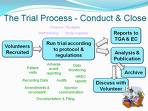
A clinical trial is a research study to answer specific questions about drugs, vaccines, new therapies or new ways of using known treatments. Clinical trials (also called medical research and research studies) are used to determine whether new drugs or treatments are both safe and effective. Carefully conducted clinical trials are the fastest and safest way to find treatments that work in people.
Participants in clinical trials can play a more active role in their own health care, gain access to new research treatments, before they are widely available and help others by contributing to medical research.
Ideas for clinical trials usually come from researchers. After researchers test new therapies or procedures in the laboratory and in animal studies, the treatments with the most promising laboratory results are moved into clinical trials. During a trial more and more information is gained about a new treatment, its risks and how well it may or may not work.
Clinical trials are sponsored or funded by a variety of organizations or individuals such as physicians, medical institutions, foundations, voluntary groups, and pharmaceutical companies, in addition to government agencies such as Indian Council Of Medical Research. Trials can take place in a variety of locations, such as hospitals, universities, doctors’ offices or community clinics.
A protocol is a study plan on which all clinical trials are based. The plan is carefully designed to safeguard the health of the participants as well as answer specific research questions. A protocol describes what types of people may participate in the trial, the schedule of tests, procedures, medications, dosages and the length of the study. While in a clinical trial, participants following protocol are seen regularly by the research staff to monitor their health and to determine the safety and effectiveness of their treatment.
A placebo is an inactive pill, liquid or powder that has no treatment value. In clinical trials, experimental treatments are often compared with placebo to assess the treatment’s effectiveness. In some studies, the participants in the control group will receive a placebo instead of an active drug or treatment.
A control is the standard by which experimental observations are evaluated. In many clinical trials, one group of patients will be given an experimental drug or treatment, while the control group is given either a standard treatment for the illness or a placebo. What are the different types of clinical trials? Treatment trials test new treatments, new combinations of drugs, or new approaches to surgery or radiation therapy. Prevention trials look for better ways to prevent disease in people who have never had the disease or to prevent a disease from returning. These approaches may include medicines, vitamins, vaccines, minerals, or life style changes. Screening trials test the best way to detect certain diseases or health conditions. Quality of life trials (or supportive care trials) explore ways to improve comfort and the quality of life for individuals with a chronic illness.
Treatment trials test new treatments, new combinations of drugs, or new approaches to surgery or radiation therapy. Prevention trials look for better ways to prevent disease in people who have never had the disease or to prevent a disease from returning. These approaches may include medicines, vitamins, vaccines, minerals, or life style changes. Screening trials test the best way to detect certain diseases or health conditions. Quality of life trials (or supportive care trials) explore ways to improve comfort and the quality of life for individuals with a chronic illness.
Clinical Research is Conducted in 4 Phases
Phase I trials
This is the first time the new drug is administered to a small number, around 20-80 healthy, informed volunteers under the close supervision of a doctor. The purpose is to determine whether the new compound is tolerated by the patient’s body and behaves in the predicted way.
Phase II trials
In this phase, the medicine is administered to a group of approximately 100-300 informed patients to determine its effect and also to check for any unacceptable side effects.
Phase III trials
In this phase, the group is between 1000 and 5000, for the company to use statistics to analyze the results. If the results are favorable, the data is presented to the licensing authorities for a commercial license.
Phase IV trials
This is a surveillance operation phase after the medicine is made available to doctors, who start prescribing it. The effects are monitored on thousands of patients to help identify any unforeseen side effects.
